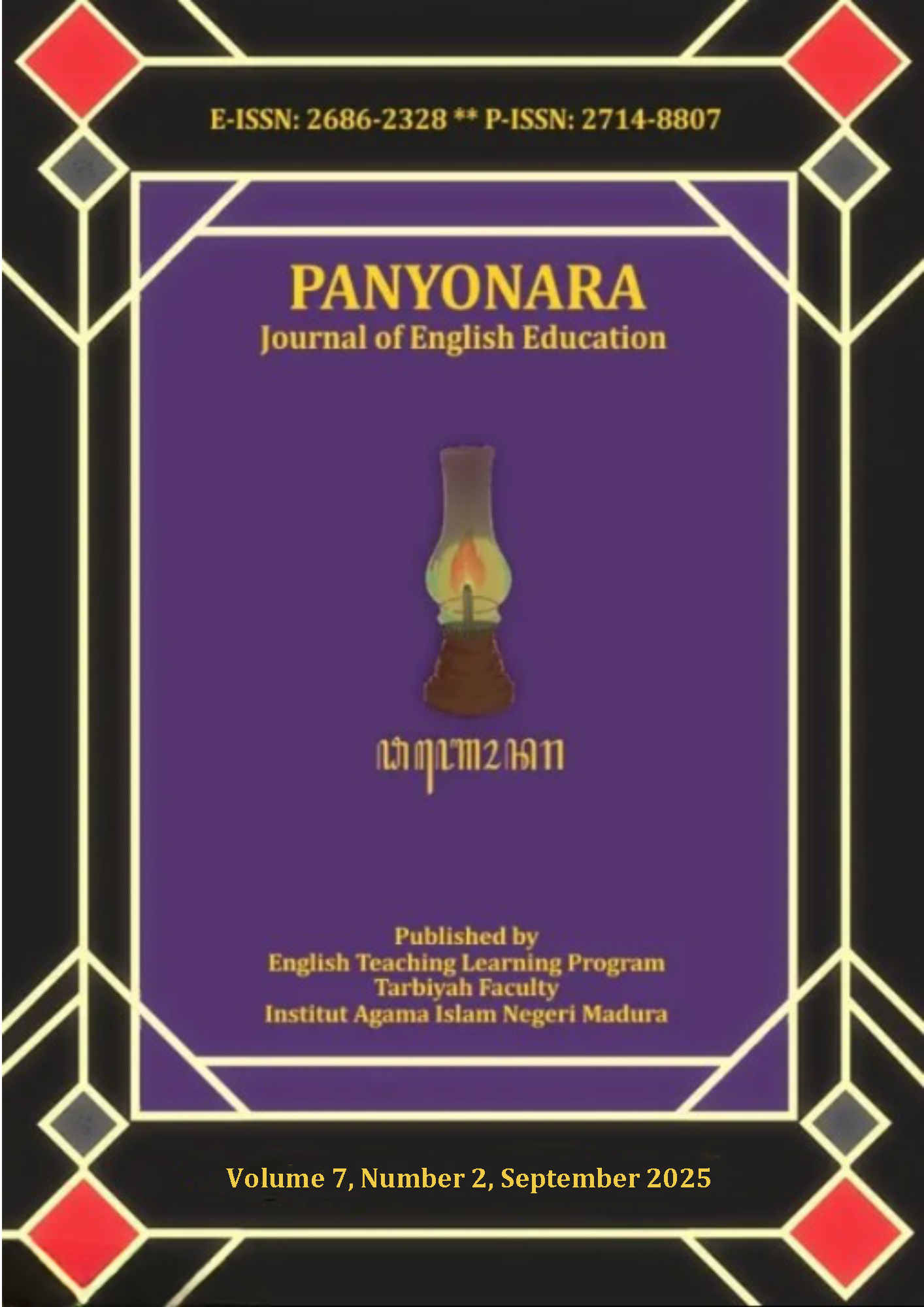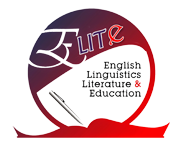From Willingness to Competence: Investigating Primary Teachers’ Readiness for EMI Implementation
 Abstract views: 238
,
Abstract views: 238
,
 pdf downloads: 124
pdf downloads: 124
Abstract
English as a Medium of Instruction (EMI) is increasingly promoted in Indonesian primary schools to accelerate bilingual competence, yet evidence on teacher readiness remains limited. This explanatory sequential qualitative-methods study examined the EMI readiness of 108 teachers from elementary schools in East Java. An adapted 16-item EMI-Readiness Scale (α =.89) and three open-ended prompts captured quantitative and qualitative data across knowledge, skills, and attitude dimensions. Descriptive statistics revealed moderate overall readiness: conceptual knowledge (M = 2.75), pedagogical–linguistic skills (M = 2.64), and attitudes (M = 2.88). Only 40 % of teachers felt confident in spoken or written English, and the lowest means concerned oral fluency (2.39) and writing (2.41). Regression analysis showed perceived policy clarity was the strongest predictor of self-efficacy (β = .42, p < .01). Cluster analysis identified three attitudinal profiles—ready-supported (28 %), conditionally willing (46 %), and reluctant (26 %). Qualitative data uncovered reliance on ad-hoc self-learning, resource shortages, and ambivalent sociocultural positioning. The findings highlight a persistent gap between policy aspirations and classroom capability, driven by limited professional development, insufficient language proficiency, unclear guidelines, and infrastructural constraints. The study proposes a phased, resource-backed professional-development agenda that integrates content-language pedagogy, collaborative mentoring, translanguaging scaffolds, and systematic monitoring to foster sustainable EMI implementation.
Downloads
References
Anh, T. (2022). Examining english as a medium of instruction in vietnam:. Crossings a Journal of English Studies, 13(2), 114-130. https://doi.org/10.59817/cjes.v13i2.453
Bahati, E., Habyarimana, H., & Tabaro, C. (2024). Investigating the implementation of english as the medium of instruction policy at the lower primary level: a case of nyabihu district in rwanda. African Journal of Empirical Research, 5(4), 606-616. https://doi.org/10.51867/ajernet.5.4.49
Bailey, K. A., Gammage, K. L., & van Ingen, C. (2019). Designing and implementing a positive body image program: Unchartered territory with a diverse team of participants. Action Research, 17(2), 146-161.
Cenoz, J. (2019). Translanguaging pedagogies and English as a lingua franca. Language Teaching, 52(1), 71-85.
Chen, H., & Zhang, Y. (2021). Teacher readiness for EMI: Challenges and opportunities in Asian contexts. Asian-Pacific Journal of Second and Foreign Language Education, 6(1), 1-18.
Chen, J., & Zhang, L. (2021). Exploring the challenges of EMI implementation in primary schools: A case study from China. International Journal of Bilingual Education and Bilingualism, 24(6), 823-838. https://doi.org/10.1080/13670050.2020.1857735
Corr, M., McSharry, J., & Murtagh, E. M. (2019). Adolescent girls’ perceptions of physical activity: A systematic review of qualitative studies. American Journal of Health Promotion, 33(5), 806-819.
Erliana, S., Cahyono, B., Widiati, U., & Basthomi, Y. (2024). The management of english as medium of instruction (emi) policy at an indonesian technological institution. Journal on English as a Foreign Language, 14(2), 704-725. https://doi.org/10.23971/jefl.v14i2.8306
Farrell, T. S. C. (2019). Standing on the shoulders of giants: Interpreting Reflective Practice in TESOL. Iranian Journal of Language Teaching Research, 7(3), 1-14. https://dx.doi.org/10.30466/ijltr.2019.120733
Feinberg, M. E. (2002). Coparenting and the transition to parenthood: A framework for prevention. Clinical child and family psychology review, 5(3), 173-195.
Galloway, N., Numajiri, T., & Rees, N. (2020). The ‘internationalisation’, or ‘englishisation’, of higher education in east asia. Higher Education, 80(3), 395-414. https://doi.org/10.1007/s10734-019-00486-1
Galloway, N. & Ruegg, R. (2020). The provision of student support on english medium instruction programmes in japan and china. Journal of English for Academic Purposes, 45, 100846. https://doi.org/10.1016/j.jeap.2020.100846
Ghimire, K. (2024). Perceptions on english as a medium of instruction in community school in nepal. KMC Journal, 6(1), 176-191. https://doi.org/10.3126/kmcj.v6i1.62339
Gläser-Zikuda, M., Zhang, C., Hofmann, F., Plößl, L., Pösse, L., & Artmann, M. (2024). Mixed methods research on reflective writing in teacher education. Frontiers in Psychology, 15, 1394641.
Han, D. H., Chen, L. J., Wei, X. C., & Song, T. H. (2023, July). An effective EMI source reconstruction method based on adaptive dynamic differential evolution. In 2023 IEEE Symposium on Electromagnetic Compatibility & Signal/Power Integrity (EMC+ SIPI) (pp. 735-739). IEEE.
Hendges, G., Rodrigues, G., & Pretto, A. (2023). Views of teachers and students about emi at a brazilian federal university: implications for language policy. Letras, 097-124. https://doi.org/10.5902/2176148568092
Johnstone, R. (2018). Languages policy and English for young learners in early education. In The Routledge handbook of teaching English to young learners (pp. 13-29). Routledge.
Joshi, B. and Paneru, N. (2025). English medium instruction in nepalese community schools: perceptions, practices, and pedagogical challenges. ILAM, 21(1), 25-35.
Khatri, K. K., & Regmi, B. P. (2022). Rethinking English as medium of instruction policy in multilingual classrooms. Journal of NELTA Gandaki, 5(1-2), 30-42.
Khramchenko, D. (2025). Englishization of education: a critical look at africa and asia. Integration of Education, 29(1), 49-67. https://doi.org/10.15507/1991-9468.029.202501.049-067
Kadel, P. (2024). Potentialities and challenges of adopting english as a medium instruction at the basic level in nepal. Pragyaratna, 6(2), 111-118. https://doi.org/10.3126/pragyaratna.v6i2.70591
Karki, T. and Karki, R. (2024). Barriers to implementing english-medium instruction in community schools of rural nepal. Educ. Quar., 5(1), 73-90. https://doi.org/10.3126/jeqtu.v5i1.76746
Khadka, B. (2025). English medium instruction in south asia: addressing equity and inclusion in education. AMC Multidisc. Res. J., 4(1), 67-78. https://doi.org/10.3126/amrj.v4i1.78677
Kim, V., & Kim, J. (2020). Roles of teacher feedback in promoting effective English-medium instruction of a business subject. Journal of Asia TEFL, 17(3), 889.
Kirkpatrick, A. (2022). Technological Integration in Education. Technology and Innovation in Education, 39(2), 78-95.
Lasagabaster, D. (2019). Multilingual language learning: A study on the integration of content and language. Journal of Multilingual and Multicultural Development, 40(5), 425-441.
Lasagabaster, D. (2021). Psychological Dimensions of Educational Technology. Applied Educational Psychology, 33(1), 45-62.
Lo, Y.Y., Othman J. (2023). Lecturers’ readiness for EMI in Malaysia higher education. PLoS ONE18(7): e0284491. https://doi.org/ 10.1371/journal.pone.0284491
Macaro, E., Tian, L., & Chu, L. (2020). First and second language use in English medium instruction contexts. Language Teaching Research, 24(3), 382-402.
MacIntyre, P. D., Baker, S. C., Clément, R., & Conrod, S. (2001). Willingness to communicate, social support, and language-learning orientations of immersion students. Studies in second language acquisition, 23(3), 369-388.
Mahara, K. (2023). Implementing english medium instruction in nepalese public schools: teachers’ perceptions. KMC Journal, 5(1), 115-126. https://doi.org/10.3126/kmcj.v5i1.52454
Mazorodze, A. H., & Mkhize, P. (2024). Exploring barriers to innovation in higher education: An empirical investigation in Zimbabwe. South African Journal of Information Management, 26(1), 1644.
Merino, J. A., & Lasagabaster, D. (2018). The effect of content and language integrated learning programmes' intensity on English proficiency: A longitudinal study. International Journal of Applied Linguistics, 28(1), 18-30.
Nguyen, H., Pham, T., & Tran, M. (2024). Navigating the confidence gap: Strategies for enhancing EMI teacher self-efficacy. RELC Journal, 55(2), 203-218. https://doi.org/10.1177/00336882231234568
Nguyen, H., Tran, T., & Pham, L. (2024). The impact of teacher confidence on EMI teaching quality and student outcomes. International Journal of Educational Research, 103, 101-115.
Nguyen, T., Hamid, M. O., & Renshaw, P. (2023). Sustainable EMI implementation: The role of teacher mentoring. International Journal of Bilingual Education and Bilingualism, 26(3), 1052-1068.
Nur, S., Nurfadhilah, A., Dewi, E., & Jamilah, J. (2023). English as medium of instruction (moi) in classroom activities: teachers’ perceptions from eastern indonesia. Joall (Journal of Applied Linguistics and Literature), 8(1), 59-74. https://doi.org/10.33369/joall.v8i1.22792
Ojong, A. and Addo, E. (2024). Advancing inclusivity, equity, and diversity in english language education: empowering underrepresented students in africa. Journal of English Language Teaching and Applied Linguistics, 6(2), 144-157. https://doi.org/10.32996/jeltal.2024.6.2.16
Parajuli, B. (2022). EMI as a Form of Cultural Hegemony. Marsyangdi Journal, 3(1), 64-71.
Phyak, P. (2023). Producing the disciplined english-speaking subjects: language policing, development ideology, and english medium of instruction policy. Language in Society, 53(2), 321-343. https://doi.org/10.1017/s0047404523000052
Pun, J., Thomas, N., & Bowen, N. (2022). Questioning the sustainability of english-medium instruction policy in science classrooms: teachers’ and students’ experiences at a hong kong secondary school. Sustainability, 14(4), 2168. https://doi.org/10.3390/su14042168
Ribeiro, J., Hendges, G., & Rodrigues, G. (2024). Emi pioneers. Colombian Applied Linguistics Journal, 26(2), 35-50. https://doi.org/10.14483/22487085.19439
Quotah, S. and Alghamdi, R. (2024). Assessing the impact and challenges of english medium instruction in saudi arabian stem programs: a comprehensive review. Asian Journal of Multidisciplinary Research & Review, 5(4), 1-27. https://doi.org/10.55662/ajmrr.2024.5401
Rahman, M., Kaur, M., & Puteh-Behak, F. (2023). EMI in Southeast Asian primary schools: Challenges and opportunities. Journal of Multilingual and Multicultural Development, 44(6), 521-535. https://doi.org/10.1080/01434632.2022.2123456
Rahman, M. (2025). Emi policy and practice divides in china, japan, malaysia and nepal. English Today, 1-7. https://doi.org/10.1017/s0266078425000136
Rahman, M. M., & Singh, M. K. M. (2022). The ideology towards English as a medium of instruction (EMI) adoption in higher education in Malaysia: A case study. 3L, Language, Linguistics, Literature, 28(2), 109-121.
Rifiyanti, H., & Dewi, D. U. (2023). English as a Medium of Instruction (EMI) in Learning Practice: Perspectives and Strategies of Educators. Tamaddun, 22(2), 183-192.
Santos, L., & Li, W. (2024). Profiling EMI teacher readiness: A comparative study of primary school teachers in Asia. Language Teaching Research, 28(3), 374-391.
Saud, M. S. (2020). English medium public schools in Nepal: A new linguistic market in education. LLT Journal: A Journal on Language and Language Teaching, 23(2), 319-333.
Shrestha, P. (2025). Students’ academic reading in EMI and assessment for social justice: the case of a university in Nepal through the lens of Honneth’s mutual recognition.
Sukardi, R., Sopandi, W., Lestari, H., & Rizki, M. (2023). Trends of english as medium instruction in science learning: review and bibliometrıc analysis. pegegog, 13(1).
Sukmawati, I. and Pujiani, T. (2024). English as medium of instruction (emi) at primary schools in indonesia: challenges and opportunities. JEEYAL, 3(1), 14-20.
Tao, Y., Xu, T., Wang, X., Liu, C., Wu, Y., Liu, M., ... & Qiu, X. (2024). The relationships between emerging adults self-efficacy and motivation levels and physical activity: a cross-sectional study based on the self-determination theory. Frontiers in Psychology, 15, 1342611.
Tanoli, M., Khan, M., & Majoka, M. (2021). English as medium of instruction at primary level: problems faced by teachers and students. Sir Syed Journal of Education & Social Research (Sjesr), 4(2), 167-174. https://doi.org/10.36902/sjesr-vol4-iss2-2021(167-174)
Tri, D. (2021). Ideologies of english‐medium instruction in vietnam. World Englishes, 42(4), 732-748. https://doi.org/10.1111/weng.12575
Wang, Y., & Chen, J. (2024). Beyond self-directed learning: Preparing teachers for comprehensive EMI implementation. Language Teaching, 57(4), 511-527.
Wei, L., & García, O. (2022). Not a first language but one repertoire: Translanguaging as a decolonizing project. RELC journal, 53(2), 313-324.
Zheng, Q. and Choi, T. (2024). English-medium instruction as an internationalisation strategy at a second-tier chinese university: instructors’ challenges and their shaping factors. Asian-Pacific Journal of Second and Foreign Language Education, 9(1). https://doi.org/10.1186/s40862-024-00295-9
ZHU, Z. (2024). Language injustice and social equity in emi policies in china. Region - Educational Research and Reviews, 6(7), 156. https://doi.org/10.32629/rerr.v6i7.2407
The journal uses an Open Access policy under a Creative Commons Attribution-NonCommercial 4.0 International License. Authors who publish with this journal agree to the following terms:
- Authors retain copyright and grant the journal right of first publication with the work simultaneously licensed under a Creative Commons Attribution License that allows others to share the work with an acknowledgment of the work's authorship and initial publication in this journal.
- Authors are able to enter into separate, additional contractual arrangements for the non-exclusive distribution of the journal's published version of the work (e.g., post it to an institutional repository or publish it in a book), with an acknowledgment of its initial publication in this journal.
- Authors are permitted and encouraged to post their work online (e.g., in institutional repositories or on their website) prior to and during the submission process, as it can lead to productive exchanges, as well as earlier and greater citation of published work.
















